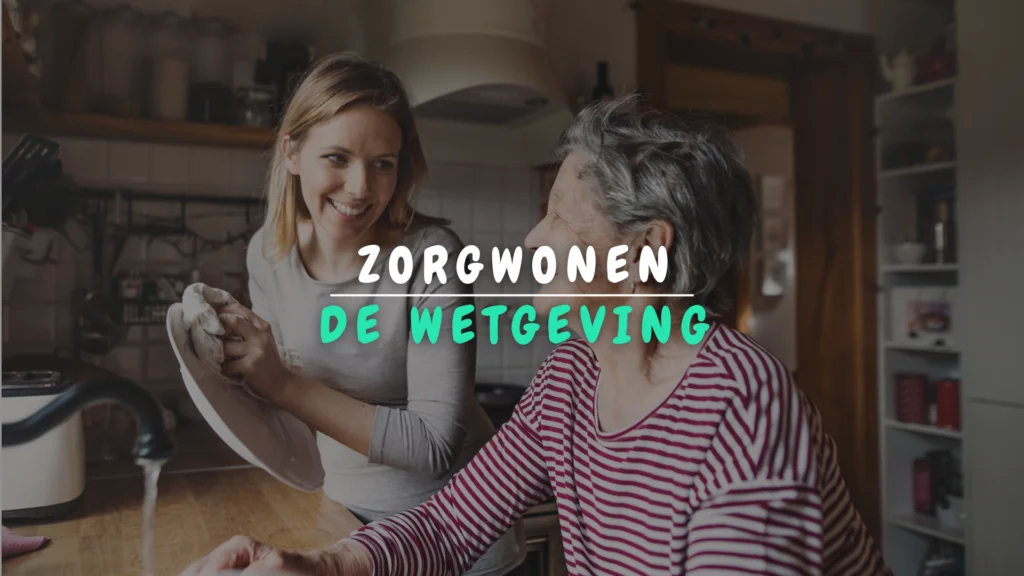Care living is allowed only with the approval of your municipality. What is care living? What are its conditions and implications? And what is the application process? You can read it here!
What is care living?
Care housing is a form of living where up to 2 persons in need of care live with or with a family member, friend or caregiver. The benefits of care living:
- Persons in need of care are given the opportunity to continue living independently.
- These dependents receive care and support from fellow residents.
- These dependents do not get into social isolation and loneliness by living with others.
What are the conditions of a care home?
Here you will find all the conditions for care housing. Pay close attention, because if you do not meet one condition, you must apply for an environmental permit.
Creation of the care home
- You create a care home unit in or near an existing, licensed home.
- You create only one care dwelling unit. Creating two (separate) or more care housing units is not allowed.
- The care home unit is smaller than the existing home.
- The healthcare housing unit must meet EPB requirements.
- The existing home may also be a rental property, as long as the owner approves.
- The (bare) ownership of the existing dwelling or the land on which the dwelling unit temporarily stands, and the dwelling unit belong to the same owner.
- Are you going to expand the existing home? If so, you must have a permit.
- Theoretically, you may not create a care dwelling unit in a newly built home, but in practice it is best to check with your municipality.
Situation 1: Care living within an existing home
- The care housing unit forms one physical unit with the main housing unit.
- The care housing unit consists of up to one-third of the gross floor area of the entire main housing unit. Spaces shared with the main residential unit should not be included.
Situation 2: Care housing within an existing building at a residence
- The care dwelling unit has a gross floor area of up to 50 m².
- You may not construct additional pavement. Except for necessary entrances to the care dwelling unit.
- The utilities of the care dwelling unit must connect to the existing utilities of the main dwelling unit.
- The wastewater discharge from the care dwelling unit shall connect to the existing water discharge from the main dwelling unit.
Situation 3: Care living in a new, temporary relocatable unit
- The maximum height of the unit is 3.5 meters.
- The unit has a maximum gross floor area of 50 m².
- The utilities of the care dwelling unit must connect to the existing utilities of the main dwelling unit.
- The wastewater discharge from the care dwelling unit shall connect to the existing water discharge from the main dwelling unit.
- The unit must be within 30 meters of the main dwelling unit, on the same lot or on a lot immediately adjacent:
- in the side yard, up to a maximum of 3 meters from the property boundaries.
- in the backyard, to within 1 meter of the property boundaries.
- in the back yard, on or against the property line provided they are against an existing dividing wall and if you do not alter this dividing wall.
- You may not construct additional pavement. Except for necessary accesses to the unit and the structure itself.
- When placing the unit, do not deforest and/or change the relief of the soil.
- The placement of the unit shall not be in a flood zone and/or spatially sensitive area. Except agricultural area with ecological value, agricultural area with ecological importance and park area.
- The unit may be on the plot for a maximum of 3 years. You may extend the duration only once for a period of up to 3 years.
- The unit must be movable. This is “a structure that must be removable in one movement. It is not intended to erect permanent foundations or structures,” according to the Flemish amending decree of June 18, 2021. Your municipality assesses the relocatability of the unit.
- Has the maximum duration expired or has care living been discontinued? Then you must remove the unit and the access created for it within 3 months.
- An architect is required when doing stability work.
Residents
You create the living unit for:
- either a maximum of 2 persons, at least one of whom is 65 years of age or older if the dependents live in the housing unit.
- either a maximum of 2 persons, at least one of whom is needy if the needy persons live in the housing unit.
- either the caregiver if the persons in need of care live in the main residence.
A needy person is:
- a person with a disability.
- A person who needs assistance to live independently.
- A person who receives or is eligible to receive an allowance from Flemish Social Protection.
Note: You may only create a care dwelling unit if the persons in need of care meet the conditions at that time. Thus, you may not create the housing unit in advance.
Start and stop
- You must report care living at startup and stop.
- Are you using the care unit for housing after the care housing stops? If so, you need an environmental permit for this.
- The person(s) in need of care must occupy the home within 2 years from the date of the notification deed. If this does not happen? Then the deed of notification expires.
What are the implications?
Grants and subsidies:
- There are no specific premiums or subsidies for care housing.
- But you might qualify for:
- the adjustment premium for those over 65.
- renovation and remodeling premiums.
- the allowance for assistive devices for persons with disabilities.
Fiscal:
- There are no tax implications related to social benefits or social advantages such as unemployment benefits.
Social rate for water:
- You are not entitled to the social rate.
- You do have the right to compensation. This is a lump sum amount roughly equivalent to 80 percent off your water usage. Contact your water supplier.
- Not entitled to the social rate? Then you may be entitled to the protected customer benefit.
Do you need a permit for a care home?
No, you do not need an environmental permit, but you are required to report the care home
How do you report a care home?
- You are required to report the property before creation, at the Flanders Environment Office.
- Register yourself in the population register when you move into the care home.
- Some municipalities require a cover letter and/or proof or statement on honor of the resident’s need for care.
- Upload these documents:
- Implantation plan
- 3 photos in color
- Ground floor plan of existing and new condition
- Ground plan floor of existing and new condition
- Cross section of the existing and new condition
Note: Do not upload any medical records or other documents with privacy-sensitive information. It is also not necessary to provide the name of the care recipient(s).
- Receive a notification within 30 days. Your notification has been acted upon or denied as of then.
- Have you not received a notification? Then the notification is tacitly deactivated.
- After acting on the deed, you may begin the executive works.

Sources: Notary Public, Flemish Parliament, Flanders
Would you like to cite this article as a source? Then use:
Stiasteny, L. (2024, May 30). Care living according to legislation. Apartment.be. Consulted on (date XX/XX/202X), from https://www.appartement.be/zorgwonen-volgens-wetgeving
Related articles:
- Cohousing according to legislation
- Living in a tiny house according to legislation
- What do you need an environmental permit for?

